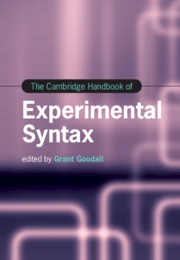Book contents
- The Cambridge Handbook of Experimental Syntax
- The Cambridge Handbook of Experimental Syntax
- Copyright page
- Contents
- Figures
- Tables
- Contributors
- Introduction
- Part I General Issues in Acceptability Experiments
- Part II Experimental Studies of Specific Phenomena
- 8 Resumptive Pronouns in English
- 9 Island Effects
- 10 The That-Trace Effect
- 11 Anaphora: Experimental Methods for Investigating Coreference
- 12 Constituent Order and Acceptability
- 13 Acceptability Judgments at the Syntax–Semantics Interface
- Part III Experimental Studies of Specific Populations and Language Families
- Part IV Experimental Syntax beyond Acceptability
- Index
- References
11 - Anaphora: Experimental Methods for Investigating Coreference
from Part II - Experimental Studies of Specific Phenomena
Published online by Cambridge University Press: 16 December 2021
- The Cambridge Handbook of Experimental Syntax
- The Cambridge Handbook of Experimental Syntax
- Copyright page
- Contents
- Figures
- Tables
- Contributors
- Introduction
- Part I General Issues in Acceptability Experiments
- Part II Experimental Studies of Specific Phenomena
- 8 Resumptive Pronouns in English
- 9 Island Effects
- 10 The That-Trace Effect
- 11 Anaphora: Experimental Methods for Investigating Coreference
- 12 Constituent Order and Acceptability
- 13 Acceptability Judgments at the Syntax–Semantics Interface
- Part III Experimental Studies of Specific Populations and Language Families
- Part IV Experimental Syntax beyond Acceptability
- Index
- References
Summary
Anaphora play a key role in syntactic theorizing, but experimental investigations of coreference – especially when using acceptability judgments – involve unique methodological challenges. Given that non-linguist participants are unlikely to be familiar with linguistic notations such as the use of subscripts, how can researchers indicate the coreference relation whose acceptability is being assessed? In other words, if a researcher wants to test whether a particular coindexation relation is acceptable, how can this information be conveyed to participants? Ignoring this issue can yield uninterpretable data. This chapter provides an in-depth discussion of different methods for indicating coreference when researchers want to elicit acceptability judgments from participants who are not trained linguists. The chapter also discusses other approaches relevant for anaphora, including antecedent-choice tasks and real-time methods (self-paced reading, eye-tracking), and explains how they differ in terms of the kind of data they yield and thus the kinds of hypotheses they can be used to investigate.
Keywords
- Type
- Chapter
- Information
- The Cambridge Handbook of Experimental Syntax , pp. 278 - 314Publisher: Cambridge University PressPrint publication year: 2021
References
- 1
- Cited by



